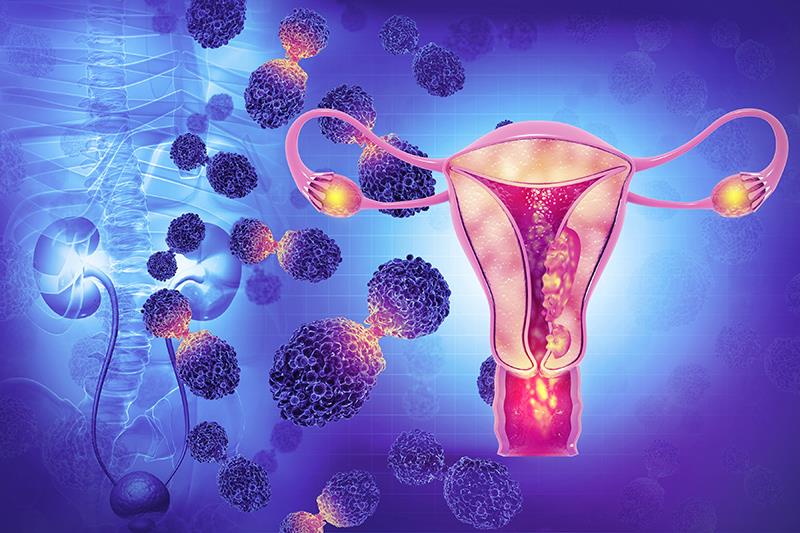Pembrolizumab plus CCRT improves survival in locally advanced cervical cancer





Adding pembrolizumab to concurrent chemoradiotherapy (CCRT) improves progression-free survival (PFS) and overall survival (OS) in patients with high-risk, locally advanced cervical cancer (LACC) compared with CCRT alone, according to the second interim analysis of the phase III ENGOT-cx11/GOG-3047/KEYNOTE-A18 trial presented at SGO 2025.
In a previous study, pembrolizumab plus chemoradiotherapy significantly improved OS in patients with LACC. Accordingly, these data, along with the results of the first interim analysis, support the use of immuno-chemotherapy as a new standard of care for this population. [Lancet 2024;403:1341-1350]
“Based on the results of the first interim analysis, the US FDA, European Commission, and other regulatory authorities have approved pembrolizumab plus CCRT for the treatment of patients with FIGO 2014 stage III–IVA cervical cancer,” said study author Dr Linda Duska from the University of Virginia School of Medicine in Charlottesville, Virginia, US.
The trial included 1,060 patients with high-risk (defined as FIGO 2014 stage IB–IIB with node-positive disease or stage III-IV, regardless of nodal status), LACC. The majority of patients had PD-L1 CPS ≥1 and 57 percent had stage III-IVA disease.
Participants were randomly assigned in a 1:1 ratio to receive pembrolizumab 200 mg Q3W for five cycles (n=529) or placebo (n=531) in addition to CCRT (cisplatin 40 mg/m2 QW for five cycles plus EBRT* followed by brachytherapy), followed by maintenance treatment with pembrolizumab 400 mg Q6W for 15 cycles or placebo, respectively.
At a median follow-up of 29.9 months, patients who received pembrolizumab plus CCRT achieved a 32-percent reduction in the risk of disease progression (PFS: hazard ratio [HR], 0.68) and a 40-percent reduced risk of second disease progression (PFS2: HR, 0.60) compared with those treated with CCRT alone. [SGO 2025, abstract LBA01]
The median PFS and PFS2 were not reached in both treatment arms.
Additionally, patients who received the combination regimen had a higher PFS rate at 36 months (62.7 percent vs 54.5 percent) than those who received CCRT alone.
In this updated analysis, patients treated with pembrolizumab plus CCRT achieved a significantly higher OS rate compared with CCRT alone at 36 months (82.6 percent vs 74.8 percent; HR, 0.67; p=0.0040), translating to a 33-percent reduction in the risk of death. Median OS was not reached in either treatment group.
The PFS and OS benefits observed with the combination regimen over CCRT alone were generally consistent across all prespecified subgroups, Duska noted.
In terms of safety, both the combination and CCRT-only groups showed similar rates of grade ≥3 all-cause adverse events (AEs; 78.2 percent vs 70.0 percent, respectively) and serious AEs (32.6 percent vs 28.5 percent).
However, the combination regimen had a higher incidence of immune-mediated AEs than the CCRT alone group (39 percent vs 17.0 percent). The most common immune-mediated AEs were hyperthyroidism and hypothyroidism, which were mostly grade 1 or 2.
The safety profile of pembrolizumab plus CCRT was manageable and consistent with known profiles of the individual therapies, with no new safety signals after longer follow-up, Duska noted.
“Overall, pembrolizumab combined with modern, high-quality CCRT and then continued maintenance [with pembrolizumab] provided statistically significant and/or clinically meaningful improvements in PFS, OS, and PFS2 vs CCRT alone in participants with newly diagnosed, previously untreated, high-risk LACC,” said Duska.
“These data support pembrolizumab plus CCRT as the new standard of care for patients with newly diagnosed, previously untreated, high-risk LACC and as an appropriate control arm in future clinical trials,” she added.